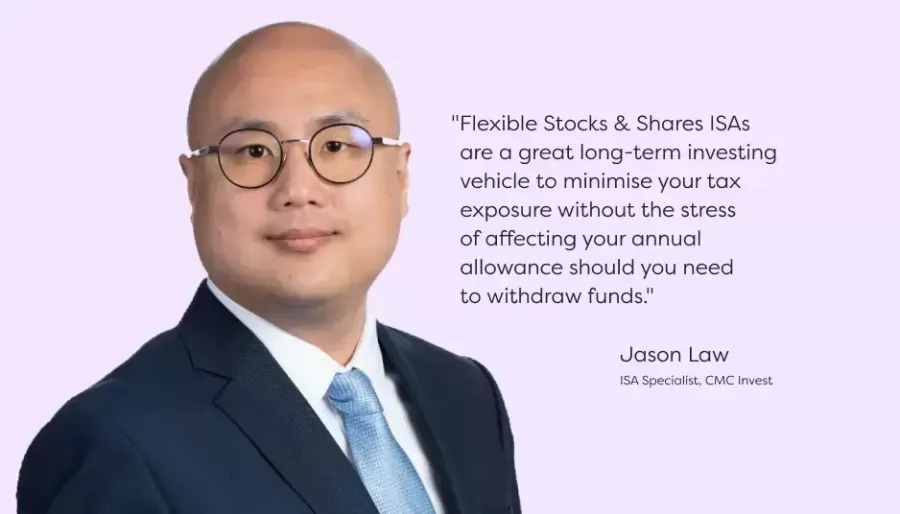Getting started with a Flexible Stocks & Shares ISA – common questions and misconceptions

Get informed
Sign up for our fortnightly Compass newsletter
Important: This information is for guidance purposes and may become out of date at any given time. It is not investment advice. Investments can rise and fall in value. We won’t make any assessment of whether the investments you choose are appropriate or suitable for you. If you are unsure of the suitability of any investment, investment service or strategy, you should seek independent financial advice. Past performance is not a reliable indicator of future results. Capital is at risk.
If you’re looking to invest in a tax-efficient manner, a Flexible Stocks & Shares ISA is worth exploring. These tax wrappers allow you to avoid paying UK capital gains and income taxes on investments held in them, which can have significant benefits in the long term.
They are also, however, sometimes misunderstood. That’s why we’ve tapped Jason Law, our ISA specialist at CMC Invest, to go over some of the questions he often hears from people curious about ISAs.
Aren’t ISAs “savings” products? Aren’t I just supposed to put cash into them?
JL: This is one of the biggest misconceptions that I hear, and it likely stems from the fact that there’s more than one type of ISA. Cash ISAs can indeed be viewed as savings products – you put cash into them and earn a certain rate of interest.
Stocks & Shares ISAs, however, allow you to put your money to work by investing in a variety of assets.

What’s the difference between my Stocks & Shares ISA and a General Investing Account?
JL: This seems like a basic question, but you’d be surprised by how many people misunderstand the differences.
When it comes to the core difference between a Stocks & Shares ISA and a General Investing Account (GIA), we’re talking about tax. When you realise returns on investments held within an ISA, you don’t pay UK capital gains tax on them. In a GIA, you do if your gains are above your annual allowance.
You also don’t pay any UK tax on income or dividends generated by investments held in an ISA. Once again, you have to pay tax on income generated within a GIA that’s above your allowance.
The other difference is that you can only deposit £20,000 each tax year into your Stocks & Shares ISA. For a GIA, that amount is unlimited.
Is my money “locked up” in a Stocks & Shares ISA once I invest it?
JL: For Stocks & Shares ISAs, this isn’t the case. You can withdraw money at any time.
Furthermore, if you opt for a Flexible Stocks & Shares ISA you can deposit funds, withdraw them and deposit them again in the same tax year without impacting your allowance. Not all providers offer Flexible Stocks & Shares ISAs, but CMC Invest does. You can read more here.
If I have a Cash ISA, can I also have a Stocks & Shares ISA?
JL: Yes, you can. You can also split your £20,000 annual limit between ISAs of different types. So, you could, in theory, put £5,000 into your Cash ISA this tax year and £15,000 into your Stocks & Shares ISA.
Can I have more than one Stocks & Shares ISA?
JL: You can, there’s no rules against having more than one account. And from April 2024, you can contribute to more than one Stocks & Shares ISA in a tax year.
So, you would, for example, be able to invest £10,000 in a Stocks & Shares ISA with one provider and £10,000 with another. But you are responsible for not exceeding your £20,000 annual allowance.
Am I stuck with the same ISA provider forever once I’ve opened my account?
JL: Not at all. You can transfer assets from one ISA to another easily. You can find out more in the FAQs section on our website here.
Additionally, one misunderstanding I always run into is people believing that transferring an ISA will impact their annual £20,000 allowance. This would only be impacted if you sold all the assets in one ISA, withdrew the cash and then deposited it in another. Opting to transfer will mean your allowance won’t be impacted.
Does my £20,000 allowance carry over to the next tax year if I don’t use it all?
JL: Unfortunately not. Unlike some other investment wrappers that allow this, you can’t carry over unused ISA allowances from one year to the next.
Once I deposit cash into my Stocks & Shares ISA, does it have to be invested?
JL: This is another common misconception that I hear a lot. This used to be the case, but the rules were changed some years ago. You can hold cash in your Stocks & Shares ISA and not invest it.
Let’s say the tax year is close to ending and you want to contribute money to your ISA to make the most of your annual allowance. If market conditions, however, make you anxious about investing that money then there’s no obligation to. You can deposit it in your account and hold it in cash until you want to invest it.
If my investments grow to more than £20,000 in value during the year, does that mean I’ve exceeded my allowance?
JL: No, it does not. The £20,000 is the maximum amount you’re allowed to contribute each tax year. If you’re fortunate enough to see your investments grow beyond that figure, or if you receive dividends that grow your capital substantially, there is no impact on whether you can continue to contribute to your ISA until you hit the £20,000 limit.
In conclusion, many people over-complicate the picture when getting started with ISAs. In reality, they’re a relatively simple tool to use that can help make your investments more tax efficient and aid you in your progress towards your financial goals.
Capital at risk.



